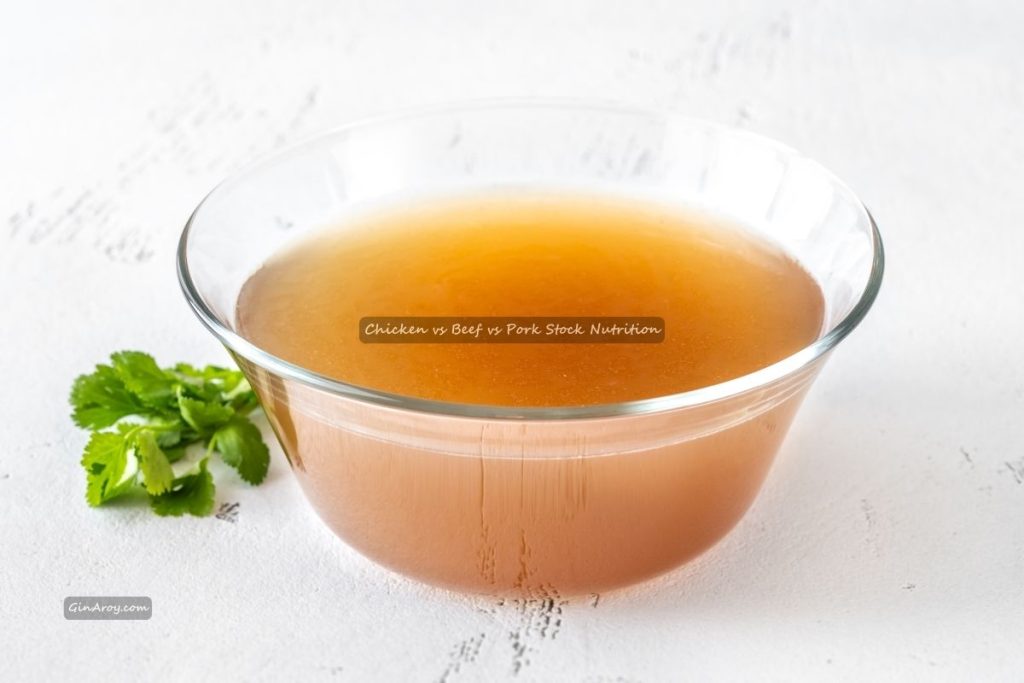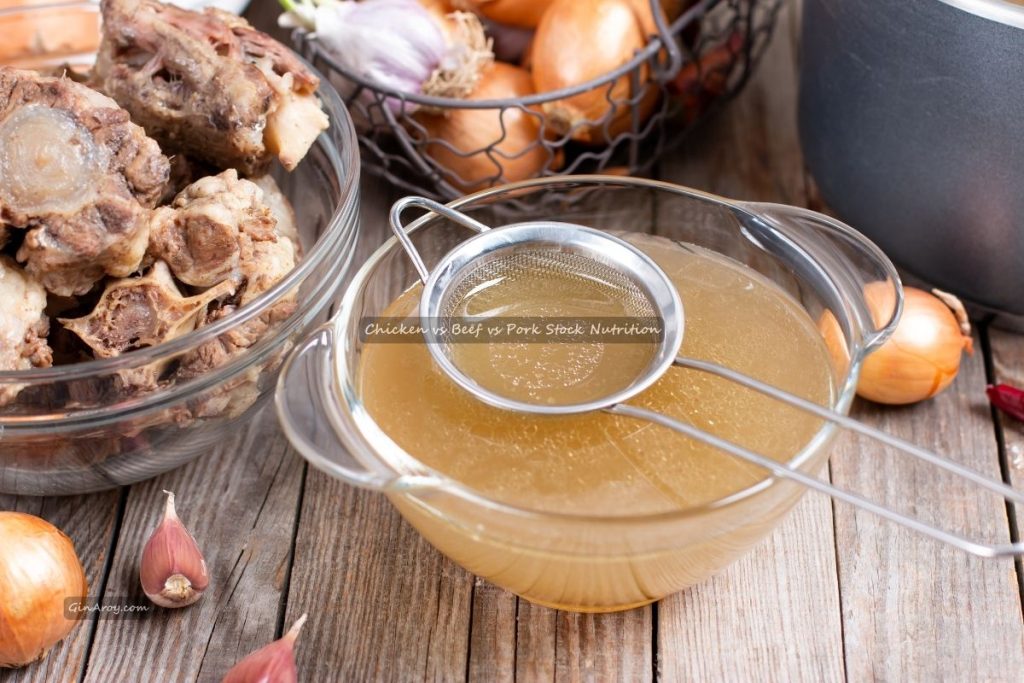- Introduction: Why Stocks Matter in Everyday Cooking
- Stock vs Broth for Soup: The Essentials
- Chicken Stock & Broth: Light, Versatile, Friendly
- Beef Stock & Broth: Deep, Savory, Sauce‑Loving
- Pork Stock & Broth: Umami‑Rich, Collagen‑Forward
- Comparative Analysis: Chicken vs Beef vs Pork Stock Nutrition
- Which Stock Has More Collagen? Methods, Parts, and Time
- Which One Is Best? Choose by Goal, Not Hype
- Homemade vs Store‑Bought Stock Flavor & Nutrition
- Technique Playbook: More Nutrition, More Clarity, Better Flavor
- Global & Thai‑Friendly Applications
- Key Takeaways & How to Choose
- FAQs
- 1. What is the main difference in chicken vs beef vs pork stock nutrition?
- 2. Which stock has more collagen in chicken vs beef vs pork stock nutrition comparisons?
- 3. Is one stock healthier when looking at chicken vs beef vs pork stock nutrition?
- 4. How should I choose between them based on chicken vs beef vs pork stock nutrition?
- 5. Does homemade make a big difference in chicken vs beef vs pork stock nutrition?
Introduction: Why Stocks Matter in Everyday Cooking
If you cook soups, sauces, or rice dishes even once a month, stock is your quiet MVP. It builds flavor, delivers body, and—when made with bones—brings gelatin that hugs ingredients with a silky mouthfeel. In home kitchens across Thailand and the world, a pot of simmering bones and aromatics is as much a ritual as it is a recipe.
This guide focuses on chicken, beef, and pork because these are the three most common bases for Asian and Western dishes alike. We’ll unpack how they differ in taste and texture, how to steer them toward specific goals (light and clear vs rich and milky), and what their typical nutrition looks like when you use bones, meat, or both. Our lens is practical: you’ll see where each shines—soups, stews, risottos, gravies, and noodle bowls—plus how to make the most of your effort at home.
This article centers on chicken vs beef vs pork stock nutrition and the real‑world culinary outcomes behind that phrase. We’ll also answer the question home cooks ask most—which stock has more collagen—and when to choose stock instead of broth (or vice versa) depending on your recipe and your goals for flavor, body, and nutrition.

You’ll find simple techniques to boost gelatin extraction, reduce excess fat, and manage sodium. And because Thai kitchens prize balance, we’ll weave in regional examples—light khao tom rice soup with chicken broth, robust beef stock for gaeng hung lay‑inspired gravies, and pork‑based soups reminiscent of ramen tonkotsu—to help you picture how each base performs.
👉 “Interested in a savory morning cup? Check out our bone broth + coffee guide. Bone Broth Coffee Benefits: The Ultimate Broffee Guide.”
Stock vs Broth for Soup: The Essentials
Before the protein‑by‑protein deep dive, let’s align on terms.
- Stock is traditionally made from bones (often with connective tissue) plus aromatics. It’s usually unsalted or very lightly seasoned. Long simmers extract gelatin, which gives that luxurious body and a slight wobble when chilled.
- Broth often starts from meat (or meaty bones) and is typically seasoned, lighter in body, and more ready‑to‑serve. Think “sippable.”
- Bone broth overlaps with stock but is marketed for extended simmering and collagen extraction. In practice, it’s a long‑simmered stock with a wellness angle.
Key culinary implications:
- If you want body and a sauce‑friendly base, use stock. If you want a ready soup, reach for broth. That’s the core of stock vs broth for soup decisions.
- Flavor comes from roasted vs white bones, aromatics, and reduction. Gelatin is about connective tissue and simmer time.
- For quick weeknights, keep both in your freezer: a neutral chicken stock for versatility and a stronger beef or pork stock for depth.
We’ll occasionally reference stock vs broth vs bone broth and gelatin in stock vs broth to answer practical questions, but the focus remains on chicken vs beef vs pork stock nutrition and flavor performance.
Chicken Stock & Broth: Light, Versatile, Friendly
Chicken stock nutrition tends to be lighter in fat than beef or pork bases (assuming you skim properly) and has a clean, approachable flavor. When made with backs, wings, and feet—connective‑tissue workhorses—you’ll extract enough gelatin for a pleasing body without overwhelming richness.
Flavor: Expect a gentle, savory profile that plays well with nearly everything—from Thai tom kha gai to Western chicken noodle soup. If you roast the bones first, you’ll amplify nuttiness and sweetness; if you keep it a white stock (no browning), you’ll get cleaner notes for poaching, rice, and light sauces.
Body & collagen: Chicken can absolutely gel if you include feet, joints, and skin and simmer long enough. It doesn’t usually set as firmly as prolonged beef or pork stocks, but it’s perfect for weeknight soups and pan sauces.

Nutrition & minerals: The nutrient profile of chicken stock varies with your ratio of bones to meat, whether you add skin, and how much you reduce. Lightly skimmed batches are modest in calories, with a small amount of protein from dissolved collagen and amino acids. Minerals (like a little calcium and phosphorus) appear in small amounts and vary widely with acidity, time, and bone type.
Best uses: Because chicken is neutral and adaptable, it’s ideal for delicate soups, risotto, braises where you don’t want red‑meat assertiveness, and best stock for soups when you’re cooking for mixed tastes.
Tips
- Feet, wing tips, and backs boost gelatin; breasts alone won’t.
- Add lemongrass, galangal, and kaffir lime leaf for Thai‑friendly brightness without salt shock.
- Skim early and often for clarity. Chill and remove the fat cap for an even leaner base.
Where it stands: On a spectrum of chicken vs beef broth taste, chicken leans lighter and sweeter, with more room for herbs and citrus. If you need “invisible” support for vegetables or seafood, chicken is the stealth hero. Later, we’ll compare how this differs from beef and pork in a side‑by‑side table.
Beef Stock & Broth: Deep, Savory, Sauce‑Loving
Beef stock nutrition tends to be fuller in body with a richer mouthfeel. Long simmers over marrow bones, knuckles, and shanks extract not only gelatin but savory compounds that read as “beefy.” Roast bones and tomato paste build a brown stock perfect for reductions.
Flavor: Darker, toastier notes—wonderful for gravies, demi‑glace, and long‑cooked stews. In Thai‑inspired kitchens, beef stock underpins hearty braises and noodle soups where a light broth would get lost.
Body & collagen: When you use collagen‑rich parts, a properly chilled pot often gels firmly. The gelatin gives sauces a glossy finish and meats a luxurious coating.
Minerals & amino acids: You may glean more from beef bone broth minerals when using long simmers and joints, though exact values vary. You’ll capture small amounts of calcium, magnesium, phosphorus, and iron compounds; again, this depends on acidity, bone type, and time.

Best uses: Heavy sauces, beef stews, and reductions. If your goal is a sauce with natural sheen, beef is king. It’s also a solid base for mushroom soups and braised grains that need backbone.
Tips
- Roast bones at high heat to encourage Maillard flavors.
- Add a splash of acidity (a little tomato or vinegar) to encourage extraction, then adjust taste at the end.
- Keep sodium low until the finish so you can reduce without oversalting.
Where it stands: Compared to chicken, beef is bolder and more assertive. In flavor differences in chicken vs beef stock, beef usually dominates, which is why it’s the go‑to for sauces and red‑meat dishes. We’ll fold this into the head‑to‑head chicken vs beef vs pork stock nutrition analysis below.
Pork Stock & Broth: Umami‑Rich, Collagen‑Forward
Pork can be the most surprising of the three. A classic pork ramen stock (tonkotsu) simmers bones long enough to emulsify fat and breakdown collagen into a creamy, opaque broth. Even without going full tonkotsu, pork neck bones and trotters bring pronounced body and sweetness.
Flavor: Distinctly savory with gentle sweetness. Pork often reads as comfort food, pairing easily with ginger, scallions, or Thai aromatics like white pepper and coriander root. Make a clear stock by blanching first, skimming aggressively, and simmering low. Or go rich by roasting and then simmering longer for deeper color.
Body & collagen: With trotters and joints, pork often sets into a firm gel when chilled, making it a contender for the stock with most collagen in typical home practice. In direct collagen in chicken broth vs beef broth comparisons, pork will frequently equal or exceed both when you use collagen‑rich parts and extend the simmer.
Nutrition & fat: Pork stocks can carry more emulsified fat (especially tonkotsu). If you’re aiming lighter, chill and remove the fat cap, or choose a clearer style. The pork stock nutrition picture changes dramatically with style: a clear, skimmed broth can be relatively modest, while a milky, long‑simmered base will be richer.
Health considerations: People sometimes ask, is pork stock healthy? As with any stock, it depends on how you make and serve it. A clear, low‑sodium broth with vegetables is a gentle choice; a rich, salty ramen broth is an indulgence best enjoyed mindfully.

Best uses: Noodle soups (ramen‑adjacent or Thai‑Chinese styles), braises for pork shoulder or ribs, and sauces that benefit from sweetness and cushion. Pork stock is also great for rice and congee when you want body without the bold beef character.
Tips
- For clean flavor, blanch bones first and rinse thoroughly.
- For richness, include trotters and neck bones; they supercharge gelatin.
- Infuse Thai personality with white pepper, garlic, and cilantro roots.
Comparative Analysis: Chicken vs Beef vs Pork Stock Nutrition
Here’s how these three typically compare. Values depend on ingredients, time, and technique; consider the table a ballpark, per‑cup (240 ml) snapshot for homemade batches. Store‑bought products vary (and often add sodium); we’ll address homemade vs store‑bought stock flavor and nutrition after the table.
| Aspect (per ~1 cup) | Chicken Stock/Broth | Beef Stock/Broth | Pork Stock/Broth |
|---|---|---|---|
| Calories | Lower to moderate (clear: ~10–40; reduced: higher) | Moderate (clear: ~20–60; reduced: higher) | Moderate to higher if emulsified (clear: ~20–60; opaque: higher) |
| Protein | Light but present; higher if reduced | Light‑moderate; increases with reduction | Light‑moderate; may feel richer due to gelatin |
| Fat | Usually lower if skimmed | Moderate; depends on marrow/fat | Can be higher; chill to remove fat cap |
| Sodium | Depends on salt; stock itself is low if unsalted | Same | Same |
| Gelatin (body) | Mild to moderate, good for soups | Moderate to strong, great for sauces | Strong, especially with trotters/long simmers |
| Minerals | Small amounts; variable | Small amounts; variable | Small amounts; variable |
| Flavor impact | Clean, versatile | Bold, beefy | Savory‑sweet, rounded |
Reading the table in your kitchen
- If you want a neutral base for vegetables, seafood, or gentle soups, chicken wins for versatility.
- For glossy sauces and deep stews, beef provides sturdy backbone and color.
- If you want cushioning body (a broth that “feels” thicker), pork is a sleeper hit—especially with trotters and longer simmering, as in pork ramen stock (tonkotsu).
Stock vs broth in practice
- Stock (bones‑forward) yields more gelatin in stock vs broth and reduces better for sauces.
- Broth (meat‑forward and seasoned) is faster and friendlier for direct sipping and quick soups.
- Stock vs broth vs bone broth comes down to goals: body, speed, or extended collagen.
Sodium matters
For all three, sodium is the big swing factor. Make unsalted or low‑sodium batches and adjust salt when finishing dishes. This lets you reduce without oversalting and keeps your base flexible across cuisines.
Which Stock Has More Collagen? Methods, Parts, and Time
The short answer to which stock has more collagen is: the one you build with the right parts and enough time. Collagen lives in connective tissues—feet, joints, skin, tendons—and transforms into gelatin with heat and moisture.
By protein
- Pork: With trotters and joints, pork often produces the firmest gel at home, especially in extended simmers. That’s why ramen shops favor trotters and neck bones for creamy, body‑rich broths.
- Beef: Knuckles, joints, and shanks are excellent. A well‑reduced beef stock sets beautifully and brings a natural sheen to sauces.
- Chicken: Wings, backs, and feet create a pleasantly jellied stock. It’s usually lighter than prolonged pork/beef versions but ideal for everyday cooking.
Technique boosts
- Longer simmer, not a violent boil: Gentle heat keeps the liquid clear and extracts gelatin efficiently.
- Acid helps: A small splash of vinegar or tomato paste can nudge extraction (adjust flavors later).
- Cool, then chill: You’ll see if it gels; remove the fat cap for leaner use.

In direct comparisons like collagen in chicken broth vs beef broth, your results depend on cut selection and time rather than the animal alone. If you cook beef shanks for 10 hours and chicken backs for 2, the beef will win. If you use chicken feet for 6 hours and lean beef bones for 3, chicken might set more firmly.
Bottom line: To maximize collagen, pick collagen‑rich parts (feet, joints, skin), simmer longer, and keep salt low until the end. This also answers most practical questions around which stock has more collagen across common home setups.
Which One Is Best? Choose by Goal, Not Hype
There’s no absolute winner—only the right choice for your dish and your diners.
For delicate soups, vegetables, seafood: Chicken’s clean profile lets other flavors sing. It’s often the best stock for soups when you need versatility and lightness.
For sauces and gravies: Beef brings depth and color. If your goal is reduction, beef stock is often the best broth for sauces (yes, it’s a stock, but you’ll see this phrase in searches!).
For body and comfort: Pork gives a cushiony mouthfeel that feels luxurious without demanding red‑meat flavors. Think congee, noodle soups, and braises.
For wellness framing: If your lens is comfort and warmth, any clear, low‑sodium broth works. If your focus is body and gelatin, choose collagen‑rich parts and time. Keep the salt and fat decisions for the finish.
For pantry strategy: Freeze in 1‑cup portions. Keep a neutral chicken stock plus a darker beef or pork stock for when you need heft. This plan solves most weekday dilemmas.
Homemade vs Store‑Bought Stock Flavor & Nutrition
Homemade lets you control salt, fat, and aromatics. It’s usually cleaner in taste and more adaptable. If you want to keep nutrition modest, skim, chill, and remove the fat cap; keep your base unsalted. If you want gelatin in stock vs broth, use bones and connective tissue and give yourself more time.
Store‑bought varies wildly:
- “Stock” vs “broth” on labels doesn’t always follow traditional definitions. Read ingredients.
- Sodium can be very high; choose low‑sodium versions and season later.
- Shelf‑stable products rarely gel; refrigerated or frozen options sometimes do.
Smart tactics
- If using boxed stock, brighten with fresh aromatics (ginger, lemongrass) and a 10‑minute simmer.
- Blend store‑bought with a small portion of homemade gelatin‑rich stock cubes to add body.
- For vegetarian days, a strong vegetable stock (mushroom stems, kombu) brings umami while keeping it meatless.
This is where stock vs broth for soup intersects with real life: keep store‑bought for emergencies, but plan occasional batch days for homemade to anchor your cooking week.
Technique Playbook: More Nutrition, More Clarity, Better Flavor
Whether you’re chasing the most soothing bowl or the glossiest sauce, these fundamentals apply to all three proteins.
1) Build for extraction
- Use collagen‑rich parts for body (feet, joints, skin, knuckles, shanks, trotters).
- Keep pieces small to increase surface area; crack large bones.
- Add a small acid source for extraction; balance flavors later.
2) Simmer gently
- A lazy burble—not a rolling boil—prevents clouding and bitterness.
- Skim early; impurities rise in the first 30–60 minutes.
3) Season last
- Salt inhibits reduction flexibility. Stay low until you taste the final dish.
- Layer aromatics late (herbs, citrus) to preserve brightness.
4) Clarify when needed
- For consomme‑like clarity, use egg‑white clarification or a fine mesh and patience.
5) Chill and portion
- Rapidly cool for food safety. Chill overnight to separate fat. Freeze in 1‑cup portions.
These steps improve homemade vs store‑bought stock flavor, let you steer calories and fat, and give you better control over chicken vs beef vs pork stock nutrition outcomes in real meals.
Global & Thai‑Friendly Applications
A quick tour to spark ideas using the three bases.
👉 “Curious which dishes define Thai cuisine? Discover them inTop 20 Most Popular Thai Foods To Try.”
Chicken
- Thai khao tom (rice soup): clear, peppery, comforting.
- Tom kha gai: coconut‑milk soup that loves a clean chicken base.
- Quick vegetable soups and poaching liquids.
Beef
- Rich gravies and pan sauces from reduced brown stock.
- Mushroom soups that need a deep anchor.
- Braises for tougher cuts that melt into tenderness.
Pork
- Thai‑Chinese noodle soups with white pepper and cilantro roots.
- Congee that benefits from gelatin‑boosted body.
- Ramen‑style bowls using pork ramen stock (tonkotsu) techniques.
Mix & match
- Blend a small portion of beef into chicken for deeper color without overwhelming.
- Use pork gel cubes to add body to a light chicken broth.
Always let cuisine guide seasoning: Thai soups lean on herbs, citrus, and fish sauce; Western sauces may prefer wine reductions and butter finishes. The foundation—stock or broth—should support, not smother, what’s in the bowl.
Key Takeaways & How to Choose
- If versatility and gentleness matter, choose chicken.
- If depth and sauce‑readiness matter, choose beef.
- If body and comfort matter, choose pork.
The rest is technique and intent: bones, time, temperature, and salt timing. Build a small freezer library—neutral chicken, bold beef, and a pork batch for body—and you can answer almost any dinner question. When comparing chicken vs beef vs pork stock nutrition, remember that homemade choices (cuts, time, fat removal, salt) are the biggest levers.
And if your question is which stock has more collagen, the honest answer is: the stock you build with collagen‑rich parts and patience. That’s the cook’s advantage—and it tastes as good as it sounds.
FAQs
1. What is the main difference in chicken vs beef vs pork stock nutrition?
Chicken stock is usually lighter in calories and fat, beef stock tends to be richer with deeper flavor, and pork stock often delivers the most collagen and a slightly sweeter taste. The exact nutrition depends on bones, simmer time, and fat removal.
2. Which stock has more collagen in chicken vs beef vs pork stock nutrition comparisons?
In most home kitchens, pork stock made with trotters or joints often yields the highest collagen, followed by beef with knuckles or shanks. Chicken feet also produce a good gel, though lighter than long-simmered beef or pork stocks.
3. Is one stock healthier when looking at chicken vs beef vs pork stock nutrition?
“Healthier” depends on your goals. Chicken stock is often leaner and versatile, beef stock provides rich flavor and minerals, and pork stock gives body and gelatin. For lower calories, skim fat and keep sodium modest in all three.
4. How should I choose between them based on chicken vs beef vs pork stock nutrition?
Choose chicken for light soups and versatile dishes, beef for deep sauces and hearty stews, and pork for body-rich noodle soups or congee. Each offers unique nutrition and flavor strengths depending on your recipe.
5. Does homemade make a big difference in chicken vs beef vs pork stock nutrition?
Yes. Homemade stocks let you control sodium, fat, and collagen content. Store-bought versions often lack gelatin and carry higher salt. By simmering bones, joints, and skin at home, you maximize both flavor and nutrition.










